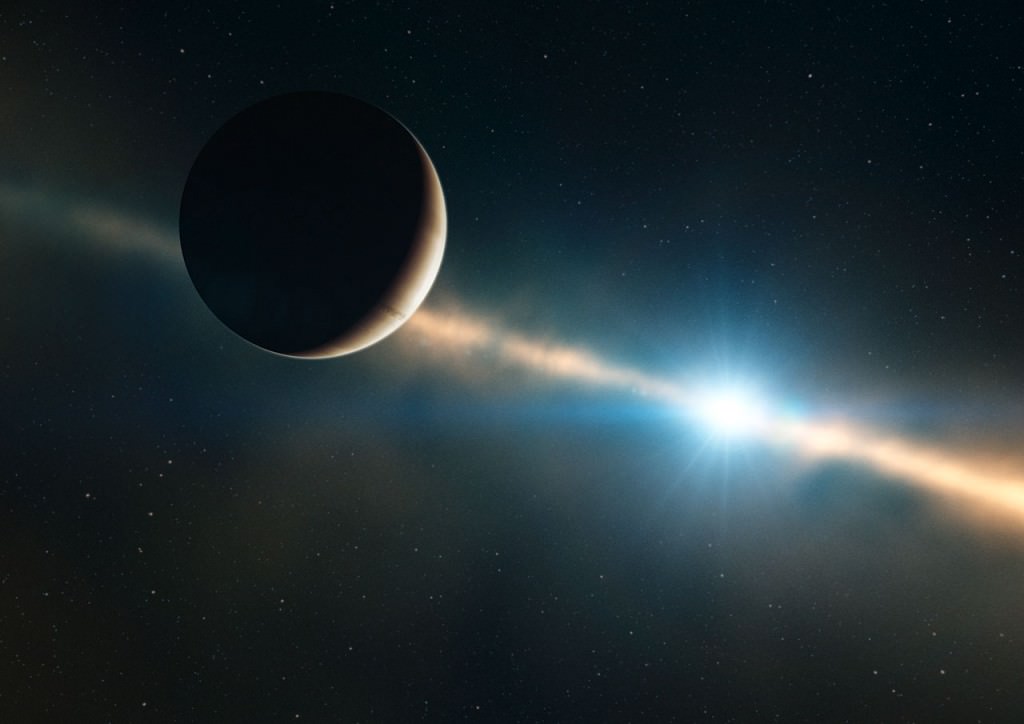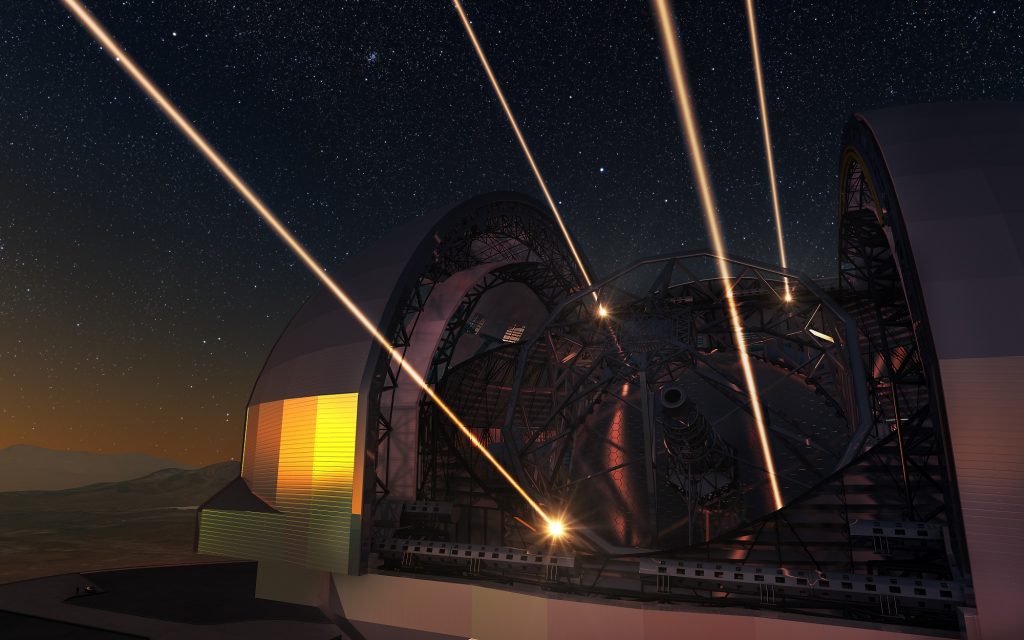Located 63.4 light-years from Earth in the constellation Pictor is the young and bright blue star, Beta Pictoris. In 2008, observations conducted from the ESO’s Paranal Observatory in Chile confirmed the presence of an extrasolar planet. This planet was Beta Pictoris b, a Super-Jupiter with an orbital period of up between 6890 and 8890 days (~19 to 24 years) that was confirmed by directly imaging it as it passed behind the star.
In August of 2019, a second planet was detected (another Super-Jupiter) orbiting closer to Beta Pictoris. However, due to its proximity to its parent star, it could only be studied through indirect means (radial velocity measurements). After conducting a reanalysis of data obtained by the VLT, astronomers with the GRAVITY collaboration were able to confirm the existence of Beta Pictoris c through direct imaging.
The researchers responsible for the research detailed their findings in two studies that appeared in the October 2nd issue of Astronomy & Astrophysics. The first was led by Mathias Nowack of the Kavli Institute for Cosmology (University of Cambridge) while the second was led by Anne-Marie Lagrange of the Laboratory of Space Studies and Instrumentation in Astrophysics (LESIA) and the Paris Observatory.

As they explain in their first study, the GRAVITY collaboration combined light from four of the VLT’s large telescopes to conduct the very first direct observations of Beta Pictoris c. This was not only the first time that a planet was directly imaged this close to its parent star, it was also the first time that direct imaging was used to confirm a detection made using the Radial Velocity (aka. Doppler Spectroscopy) method.
For decades, astronomers have relied on radial velocity measurements to detect the presence of exoplanets. With hundreds of candidates discovered to date, it has been the second-most popular method (after the Transit Method) and is often combined with transits to confirm the existence of exoplanets. However, never before have candidates discovered using the radial velocity method been confirmed by direct observation.
This was only possible because of the GRAVITY instrument, a second-generation device that is part of the VLT’s Interferometer (VLTI). This instruments combines light from four VLT telescopes – either the four Unit Telescopes or the four Auxiliary Telescopes, each of which are assisted by Adaptive Optics (AO) – and then combines them into a virtual telescope, allowing for unprecedented detail and sensitivity.
As Frank Eisenhauer, the lead scientist of the GRAVITY project at the Max Planck Institute for Extraterrestrial Physics (MPE), said in a recent institute statement:
“It is amazing, what level of detail and sensitivity we can achieve with GRAVITY. We are just starting to explore stunning new worlds, from the supermassive black hole at the centre of our galaxy to planets outside the solar system.”

At the same time, the team was only able to observe Beta Pictoris c because new radial velocity measurements were able to precisely establish the orbital motion of the planet. This was the subject of the second paper, where they show how a combination of high-contrast imaging, long baseline interferometry, and radial velocity data allowed them to precisely predict the position of Beta Pictoris b so that GRAVITY was able to find it.
Their observations also allowed them to further constrain the orbital and physical properties of Beta Pictoris b and c and predict the closest approaches of both planets as well. What this revealed, however, was rather puzzling to the GRAVITY team. Beta Pictoris c is about 8 times as massive as Jupiter and is roughly 2.7 AU away from its star – about the same distance as the Main Asteroid Belt from the Sun.
And yet, c is about six times fainter than Beta Pictoris b, which orbits its star at a distance of around 9.8 AU, which is equivalent to the distance between Saturn and the Sun. This raises the question of just how large and massive it must be in order for it to be reflecting six times as much light. At the moment, mass estimates for b are less well-constrained, ranging between 10 and 11 Jupiter masses.
But as they indicate, future observations using the radial velocity method will be able to answer this question. The only problem is that it will take several years, since Beta Pictoris b takes about 28 years to complete a single orbit around its star. Additional data might also be provided by GRAVITY+, the next-generation instrument that is currently under development.

As Paul Molliere, postdoc at MPIA who models exoplanet spectra, added:
“We used GRAVITY before to obtain spectra of other directly imaged exoplanets, which themselves already contained hints on their formation process. This brightness measurement of Beta Pictoris c, combined with its mass, is a particularly important step to constraining our planet formation models.”
The team’s results also allowed them to constrain the presence of additional planets in the Beta Pictor system. Thanks to the combined measurements and data, they are able to exclude the presence of planets that are more than 2.5 times as massive as Jupiter with 3 AU of the star; planets that are more than 3.5 Jupiter masses between 3 and 7.5 AU, and more than 1-2 Jupiter masses beyond 7.5 AU.
But perhaps the most impressive takeaway from this research is how astronomers can now combine the greatest assets from direct and indirect methods for exoplanet study. As they explained in the first study, direct detection is more sensitive to planets orbiting at a large distance from their host star while indirect methods are more sensitive to planets with a small orbital period.
According to Nowak, this opens the door to new studies that can directly image planets with tighter orbits, which is where potentially-habitable and “Earth-like” (rocky) planets are generally found. “This means, we can now obtain both the brightness and the mass of this exoplanet,” he said. “As a general rule, the more massive the planet, the more luminous it is.”

One of the most highly-anticipated developments for exoplanet studies in the near future is the way next-generation telescopes and instruments will allow for direct imaging studies of tightly-bound rocky planets. This will finally allow astronomers to obtain spectra from the atmospheres of the many potentially-habitable worlds that have been discovered in the past few decades.
By assessing the composition of these planets’ atmospheres, we will finally be able to say with certainty which of them is capable of supporting life as we know it.
Further Reading: MPI, Astronomy & Astrophysics, A&A
"light" - Google News
October 05, 2020 at 07:26AM
https://ift.tt/34nXZFd
Those are Exoplanets. You’re Looking at Actual Exoplanets 63 Light-Years Away! - Universe Today
"light" - Google News
https://ift.tt/2Wm8QLw
https://ift.tt/2Stbv5k
Bagikan Berita Ini















0 Response to "Those are Exoplanets. You’re Looking at Actual Exoplanets 63 Light-Years Away! - Universe Today"
Post a Comment